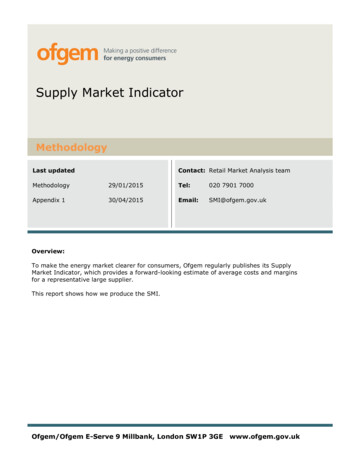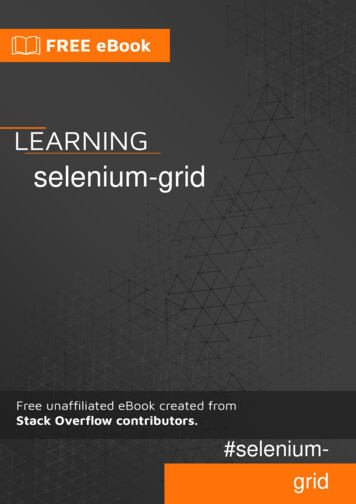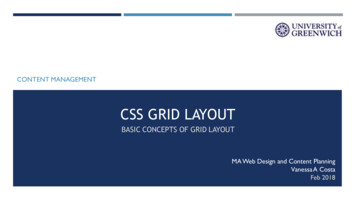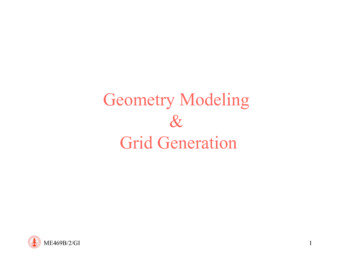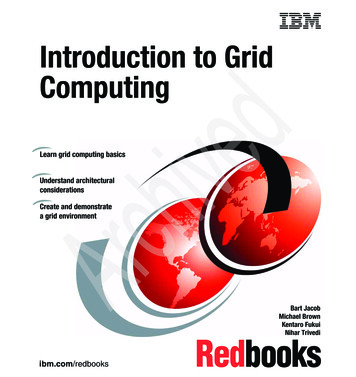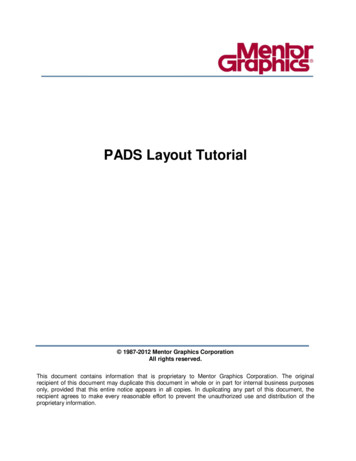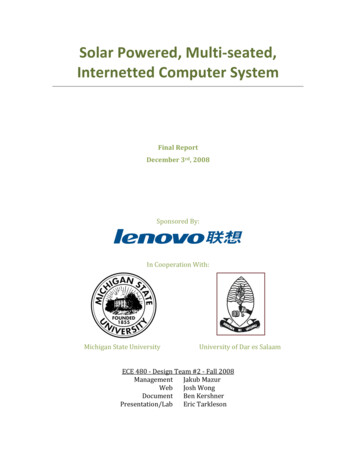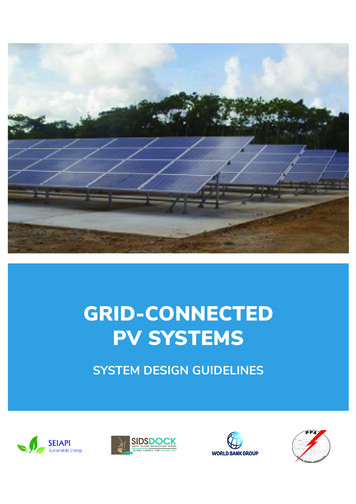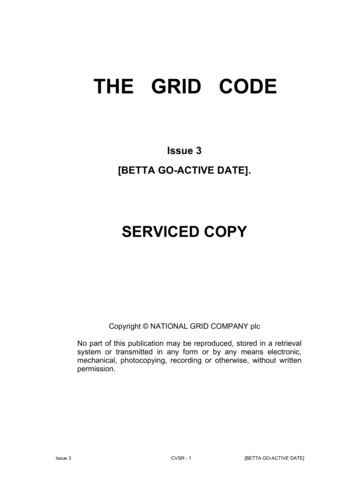
Transcription
THE GRID CODEIssue 3[BETTA GO-ACTIVE DATE].SERVICED COPYCopyright NATIONAL GRID COMPANY plcNo part of this publication may be reproduced, stored in a retrievalsystem or transmitted in any form or by any means electronic,mechanical, photocopying, recording or otherwise, without writtenpermission.Issue 3CVSR - 1[BETTA GO-ACTIVE DATE]
THIS DOCUMENT IS ISSUED BY:NATIONAL GRID COMPANY PLCCOMMERCIAL, INDUSTRY CODES UNITNATIONAL GRID TRANSCO HOUSEWARWICK TECHNOLOGY PARKGALLOWS HILLWARWICKCV34 6DATEL: 01926 656335REGISTERED OFFICE:Issue 31-3 StrandLondonWC2N 5EHCVSR - 2[BETTA GO-ACTIVE DATE]
THE GRID CODECONTENTS(PREFACE(which does not formpart of the Grid CodeGLOSSARY AND DEFINITIONS(GD)PLANNING CODE(PC)CONNECTION CONDITIONS(CC)OPERATING mand ForecastsOperational Planning and DataProvisionDeletedDeletedTesting and MonitoringDemand ControlOperational LiaisonSafety Co-ordinationContingency PlanningEvent Information SupplyNumbering and Nomenclature ofHV Apparatus at Certain SitesSystem TestsBALANCING CODESBC1BC2BC3Issue 3(PF)))(BC)Pre Gate Closure ProcessPost Gate Closure ProcessFrequency Control ProcessDATA REGISTRATION CODE(DRC)GENERAL CONDITIONS(GC)(REVISIONS(( R )))which does not formpart of the Grid CodeC-1[BETTA GO-ACTIVE DATE]
PREFACE1.The operating procedures and principles governing NGC's relationship with all Users of theGB Transmission System, be they Generators, Suppliers or Non-Embedded Customersare set out in the Grid Code. The Grid Code specifies day-to-day procedures for bothplanning and operational purposes and covers both normal and exceptional circumstances.2.The Grid Code is designed to permit the development, maintenance and operation of anefficient, co-ordinated and economical GB Transmission System, to facilitate competition inthe generation and supply of electricity and is conceived as a statement of what is optimal(particularly from a technical point of view) for all Users and NGC itself in relation to theplanning, operation and use of the GB Transmission System. It seeks to avoid any unduediscrimination between Users and categories of Users.3.The Grid Code is divided into the following sections:-Issue 3(a)a Planning Code which provides generally for the supply of certain information byUsers in order for NGC to undertake the planning and development of the GBTransmission System;(b)Connection Conditions, which specify the minimum technical, design andoperational criteria which must be complied with by NGC at Connection Sites andby Users connected to or seeking connection with the GB Transmission Systemor by Generators (other than in respect of Small Power Stations) connected toor seeking connection to a User's System;(c)an Operating Code, which is split into a number of sections and deals withDemand forecasting (OC1); the co-ordination of the outage planning process inrespect of Large Power Stations, the GB Transmission System and UserSystems for construction, repair and maintenance, and the provision of certaintypes of Operating Margin data (OC2); testing and monitoring of Users (OC5);different forms of reducing Demand (OC6); the reporting of scheduled andplanned actions, and unexpected occurrences such as faults (OC7); the coordination, establishment and maintenance of Isolation and Earthing in order thatwork and/or testing can be carried out safely (OC8); certain aspects ofcontingency planning (OC9); the provision of written reports on occurrences suchas faults in certain circumstances (OC10); the procedures for numbering andnomenclature of HV Apparatus at certain sites (OC11); and the procedures forthe establishment of System Tests (OC12);(d)a Balancing Code, which is split into three sections and deals with thesubmission of BM Unit Data from BM Participants, and of certain otherinformation, for the following day and ahead of Gate Closure (BC1); the post GateClosure process (BC2); and the procedures and requirements in relation toSystem Frequency control (BC3);PF - 1[BETTA GO-ACTIVE DATE]
4.Issue 3(e)a Data Registration Code, which sets out a unified listing of all data required byNGC from Users, and by Users from NGC, under the Grid Code;(f)General Conditions, which are intended to ensure, so far as possible, that thevarious sections of the Grid Code work together and work in practice and includeprovisions relating to the establishment of a Grid Code Review Panel and otherprovisions of a general nature.This Preface is provided to Users and to prospective Users for information only and doesnot constitute part of the Grid Code.PF - 2[BETTA GO-ACTIVE DATE]
GLOSSARY AND DEFINITIONS(G & D)1.In the Grid Code the following words and expressions shall, unless the subject matter or contextotherwise requires or is inconsistent therewith, bear the following meanings:ActThe Electricity Act 1989 (as amended by the Utilities Act 2000) and theEnergy Act 2004)Active EnergyThe electrical energy produced, flowing or supplied by an electric circuitduring a time interval, being the integral with respect to time of theinstantaneous power, measured in units of watt-hours or standard multiplesthereof, ie:1000 Wh 1 kWh1000 kWh 1 MWh1000 MWh 1 GWh1000 GWh 1 TWh.Active PowerThe product of voltage and the in-phase component of alternating currentmeasured in units of watts and standard multiples thereof, ie:1000 Watts 1 kW1000 kW 1 MW1000 MW 1 GW1000 GW 1 TW.AffiliateIn relation to any person, any holding company or subsidiary of such personor any subsidiary of a holding company of such person, in each case withinthe meaning of Section 736, 736A and 736B of the Companies Act 1985 assubstituted by section 144 of the Companies Act 1989 and, if that lattersection is not in force at the Transfer Date, as if such section were in forceat such date.Ancillary ServiceA System Ancillary Service and/or a Commercial Ancillary Service, asthe case may be.Ancillary ServicesAgreementAn agreement between a User and NGC for the payment by NGC to thatUser in respect of the provision by such User of Ancillary Services.Annual Average ColdSpell Conditions orACS ConditionsA particular combination of weather elements which gives rise to a level ofpeak Demand within an NGCa Financial Year which has a 50% chance ofbeing exceeded as a result of weather variation alone.Apparent PowerThe product of voltage and of alternating current measured in units ofvoltamperes and standard multiples thereof, ie:1000 VA 1 kVAIssue 3GD - 1[BETTA GO-ACTIVE DATE]
1000 kVA 1 MVA.ApparatusOther than in OC8, means all equipment in which electrical conductors areused, supported or of which they may form a part. In OC8 it means HighVoltage electrical circuits forming part of a System on which SafetyPrecautions may be applied to allow work and/or testing to be carried outon a System.Area ManagerA manager appointed by NGC whose management unit is a geographicalarea embracing part of the NGC Transmission System.Authorised ElectricityOperatorAny person (other than NGC in its capacity as operator of the NGCGBTransmission System) who is authorised under the Act to generate,transmitparticipate in the transmission of, distribute or supply electricity.Automatic VoltageRegulator or AVRA continuously acting automatic excitation system to control a GeneratingUnit terminal voltage.Authority for AccessAn authority which grants the holder the right to unaccompanied access tosites containing exposed HV conductors.Authority, TheThe Authority established by section 1 (1) of the Utilities Act 2000AuxiliariesAny item of Plant and/or Apparatus not directly a part of the boiler plant orGenerating Unit, but required for the boiler plant's or Generating Unit'sfunctional operation.Auxiliary DieselEngineA diesel engine driving a Generating Unit which can supply a Unit Boardor Station Board, which can start without an electrical power supply fromoutside the Power Station within which it is situated.Auxiliary Gas TurbineA Gas Turbine Unit, which can supply a Unit Board or Station Board,which can start without an electrical power supply from outside the PowerStation within which it is situated.Average ConditionsThat combination of weather elements within a period of time which is theaverage of the observed values of those weather elements duringequivalent periods over many years (sometimes referred to as normalweather).Back-Up ProtectionProtection equipment or system which is intended to operate when asystem fault is not cleared in due time because of failure or inability of theMain Protection to operate or in case of failure to operate of a circuitbreaker other than the associated circuit breaker.Balancing andSettlement Code orThe code of that title as from time to time amended.Issue 3GD - 2[BETTA GO-ACTIVE DATE]R
BSCBalancing Code or BCThat portion of the Grid Code which specifies the Balancing Mechanismprocess.Balancing MechanismHas the meaning set out in theNGC’s Transmission LicenceBalancing MechanismReporting Agent orBMRAHas the meaning set out in the BSC.Balancing MechanismReporting Service orBMRSHas the meaning set out in the BSC.Balancing PrinciplesStatementA statement prepared by NGC in accordance with Special ConditionAA4C16 of the NGC’s Transmission Licence.Bid-Offer Acceptancea)A communication issued by NGC in accordance with BC2.7; orb)an Emergency Instruction to the extent provided for in BC2.9.2.3.Bid-Offer DataHas the meaning set out in the BSC.Bilateral AgreementHas the meaning set out in the NGC’s Transmission LicenceBlack StartThe procedure necessary for a recovery from a Total Shutdown or PartialShutdown.Black Start CapabilityAn ability in respect of a Black Start Station, for at least one of itsGensets to Start-Up from Shutdown and to energise a part of theSystem and be Synchronised to the System upon instruction from NGC,within two hours, without an external electrical power supply.Black Start StationsPower Stations which are registered, pursuant to the BilateralAgreement with a User, as having a Black Start Capability.Black Start TestA Black Start Test carried out by a Generator with a Black Start Station,on the instructions of NGC, in order to demonstrate that a Black StartStation has a Black Start Capability.BM ParticipantA person who is responsible for and controls one or more BM Units. Forthe avoidance of doubt, it does not imply that they must be active in theBalancing Mechanism.Issue 3GD - 3[BETTA GO-ACTIVE DATE]
BM UnitHas the meaning set out in the BSC, except that for the purposes of theGrid Code the reference to “Party” in the BSC shall be a reference toUser.BM Unit DataThe collection of parameters associated with each BM Unit, as describedin Appendix 1 of BC1.Boiler Time ConstantDetermined at Registered Capacity, the boiler time constant will beconstrued in accordance with the principles of the IEEE Committee Report"Dynamic Models for Steam and Hydro Turbines in Power System Studies"published in 1973 which apply to such phrase.British Standards orBSThose standards and specifications approved by the British StandardsInstitution.BSCCoHas the meaning set out in the BSC.BSC PanelHas meaning set out for “Panel” in the BSC.BS Station TestA Black Start Test carried out by a Generator with a Black Start Stationwhile the Black Start Station is disconnected from all external alternatingcurrent electrical supplies.BS Unit TestA Black Start Test carried out on a Generating Unit or a CCGT Unit, asthe case may be, at a Black Start Station while the Black Start Stationremains connected to an external alternating current electrical supply.Business DayAny week day (other than a Saturday) on which banks are open fordomestic business in the City of London.Cancellation ofNGCGB TransmissionSystem WarningThe notification given to Users when a NGCGB Transmission SystemWarning is cancelled.Caution NoticeA notice conveying a warning against interference.CENELECEuropean Committee for Electrotechnical Standardisation.CCGT Module MatrixThe matrix described in Appendix 1 to BC1 under the heading CCGTModule Matrix.CCGT ModulePlanning MatrixA matrix in the form set out in Appendix 3 of OC2 showing the combinationof CCGT Units within a CCGT Module which would be running in relationto any given MW output.Issue 3GD - 4[BETTA GO-ACTIVE DATE]R
Cluster1. Before TelemetryA cluster of wind turbines will be formed when the total wind capacitywithin any circle of five kilometre radius has a Registered Capacity of notless than 5MW2. After TelemetryAny wind turbine installed within a five kilometer radius of the anemometerposition (whether installed before or after the installation of thatanemometer) will be deemed to be within the cluster for that anemometerand will not count towards the creation of any new cluster. All other windturbines may count towards the creation of further clusters.Combined Cycle GasTurbine Module orCCGT ModuleA collection of Generating Units (registered as a CCGT Module under thePC) comprising one or more Gas Turbine Units (or other gas basedengine units) and one or more Steam Units where, in normal operation,the waste heat from the Gas Turbines is passed to the water/steamsystem of the associated Steam Unit or Steam Units and where thecomponent units within the CCGT Module are directly connected by steamor hot gas lines which enable those units to contribute to the efficiency ofthe combined cycle operation of the CCGT Module.Combined Cycle GasTurbine Unit or CCGTUnitA Generating Unit within a CCGT Module.Commercial AncillaryServicesAncillary Services, other than System Ancillary Services, utilised byNGC in operating the Total System if a User (or other person) has agreedto provide them under an Ancillary Services Agreement or under aBilateral Agreement with payment being dealt with under an AncillaryServices Agreement or in the case of Externally InterconnectedSystem Operators or Interconnector Users, under any other agreement(and in the case of Externally Interconnected System Operators andInterconnector Users includes ancillary services equivalent to or similarto System Ancillary Services).Committed ProjectPlanning DataData relating to a User Development once the offer for a CUSC Contractis accepted.Completion DateHas the meaning set out in the Bilateral Agreement with each User tothat term or in the absence of that term to such other term reflecting thedate when a User is expected to connect to or start using the NGCGBTransmission System.ComplexA Connection Site together with the associated Power Station and/orNetwork Operator substation and/or associated Plant and/or Apparatus,as appropriate.ConnectionThat portion of the Grid Code which is identified as the ConnectionIssue 3GD - 5[BETTA GO-ACTIVE DATE]
Conditions or CCConditions.Connection EntryCapacityHas the meaning set out in the CUSCConnected PlanningDataData which replaces data containing estimated values assumed forplanning purposes by validated actual values and updated estimates forthe future and by updated forecasts for Forecast Data items such asDemand.Connection PointA Grid Supply Point or Grid Entry Point, as the case may be.Connection SiteAn NGCA Transmission Site or User Site, as the case may be.ConstructionAgreementHas the meaning set out in the NGC’s Transmission LicenceContingency ReserveThe margin of generation over forecast Demand which is required in theperiod from 24 hours ahead down to real time to cover againstuncertainties in Large Power Station availability and against both weatherforecast and Demand forecast errors.Control CallsA telephone call whose destination and/or origin is a key on the controldesk telephone keyboard at an NGCa Transmission Control Centre andwhich has the right to exercise priority over (ie. disconnect) a call of alower status.Control CentreA location used for the purpose of control and operation of the NGCGBTransmission System or a User System other than a Generator'sSystem or an External System.Control PersonThe term used as an alternative to "Safety Co-ordinator" on the SiteResponsibility Schedule only.Control PhaseThe Control Phase follows on from the Programming Phase and coversthe period down to real time.Control PointThe point from which:a) A Non-Embedded Customer's Plant and Apparatus is controlled; orb) A BM Unit, in England or Wales at a Large Power Station or at aMedium Power Station or with a Demand Capacity with a magnitudeof 50MW or more (in England and Wales) or 5MW or more (inScotland), is physically controlled by a BM Participant; orc) In the case of any other BM Unit, data submission is co-ordinated for aBM Participant and instructions are received from NGC,Issue 3GD - 6[BETTA GO-ACTIVE DATE]R
as the case may be. For a Generator this will normally be at a PowerStation. In the case of a BM Unit of an Interconnector User, the ControlPoint will be the Control Centre of the relevant ExternallyInterconnected System Operator.Control TelephonyThe method by which a User's Responsible Engineer/Operator andNGC Control Engineer(s) speak to one another for the purposes ofcontrol of the Total System in both normal and emergency operatingconditions.CUSCHas the meaning set out in the NGC’s Transmission LicenceCUSC ContractOne or more of the following agreements as envisaged in SupplementaryStandard Condition C7F1 of the NGC’s Transmission Licence:(a) the CUSC Framework Agreement;(b) a Bilateral Agreement;(c) a Construction Agreementor a variation to an existing Bilateral Agreement and/or ConstructionAgreement;CUSC FrameworkAgreementHas the meaning set out in the NGC’s Transmission LicenceCustomerA person to whom electrical power is provided (whether or not he is thesame person as the person who provides the electrical power).Customer DemandManagementReducing the supply of electricity to a Customer or disconnecting aCustomer in a manner agreed for commercial purposes between aSupplier and its Customer.Customer DemandManagementNotification LevelThe level above which a Supplier has to notify NGC of its proposed orachieved use of Customer Demand Management which is 12 MW inEngland and Wales and 5 MW in Scotland.Customer GeneratingPlantA Power Station or Generating Unit of a Customer to the extent that itoperates the same exclusively to supply all or part of its own electricityrequirements, and does not export electrical power to any part of the TotalSystem.Data RegistrationCode or DRCThat portion of the Grid Code which is identified as the Data RegistrationCode.Data Validation,Consistency andDefaulting RulesThe rules relating to validity and consistency of data, and default data to beapplied, in relation to data submitted under the Balancing Codes, to beapplied by NGC under the Grid Code as set out in the document “DataValidation, Consistency and Defaulting Rules” - Issue 6, dated 25th May2004. The document is available on the National Grid website or uponIssue 3GD - 7[BETTA GO-ACTIVE DATE]
request from NGC.De-LoadThe condition in which a Genset has reduced or is not delivering electricalpower to the System to which it is Synchronised.DemandThe demand of MW and Mvar of electricity (i.e. both Active and ReactivePower), unless otherwise stated.Demand CapacityHas the meaning as set out in the BSC.Demand ControlAny or all of the following methods of achieving a Demand reduction:(a) Customer voltage reduction initiated by Network Operators (otherthan following an instruction from NGC);(b) Customer Demand reduction by Disconnection initiated by NetworkOperators (other than following an instruction from NGC);(c) Demand reduction instructed by NGC;(d) automatic low Frequency Demand Disconnection;(e) emergency manual Demand Disconnection.Demand ControlNotification LevelThe level above which a Network Operator has to notify NGC of itsproposed or achieved use of Demand Control which is 12 MW in Englandand Wales and 5 MW in Scotland.Designed MinimumOperating LevelThe output (in whole MW) below which a Genset has no High FrequencyResponse capability.De-Synchronisea)The act of taking a Generating Unit off a System to which it has beenSynchronised, by opening any connecting circuit breaker; orb)The act of ceasing to consume electricity at an importing BM Unit;and the term "De-Synchronising" shall be construed accordingly.De-synchronisedIsland(s)Has the meaning set out in OC9.5.1(a)Detailed Planning Data Detailed additional data which NGC requires under the PC in support ofStandard Planning Data. Generally it is first supplied once a BilateralAgreement is entered into.DiscriminationIssue 3The quality where a relay or protective system is enabled to pick out andcause to be disconnected only the faulty Apparatus.GD - 8[BETTA GO-ACTIVE DATE]R
DisconnectionThe physical separation of Users (or Customers) from the NGCGBTransmission System or a User System as the case may be.Disputes ResolutionProcedureThe procedure described in the CUSC relating to disputes resolution.Distribution CodeThe distribution code required to be drawn up by each ElectricityDistribution Licence holder and approved by the Authority, as from timeto time revised with the approval of the Authority.Dynamic ParametersThose parameters listed in Appendix 1 to BC1 under the heading BM UnitData – Dynamic Parameters.Earth Fault FactorAt a selected location of a three-phase System (generally the point ofinstallation of equipment) and for a given System configuration, the ratio ofthe highest root mean square phase-to-earth power Frequency voltage ona sound phase during a fault to earth (affecting one or more phases at anypoint) to the root mean square phase-to-earth power Frequency voltagewhich would be obtained at the selected location without the fault.EarthingA way of providing a connection between conductors and earth by anEarthing Device which is either:(a) Immobilised and Locked in the earthing position. Where the EarthingDevice is Locked with a Safety Key, the Safety Key must be securedin a Key Safe and the Key Safe Key must be retained in safe custody:or(b) maintained and/or secured in position by such other method whichmust be in accordance with the Local Safety Instructions of NGC orthe Safety Rules of the Relevant Transmission Licensee or thatUser, as the case may be.Earthing DeviceA means of providing a connection between a conductor and earth beingof adequate strength and capability.Electrical StandardA standard listed in the Annex to the General Conditions.Electricity CouncilThat body set up under the Electricity Act, 1957.Electricity DistributionLicenceThe licence granted pursuant to Section 6(1) (c) of the Act.Electricity SupplyIndustry ArbitrationAssociationThe unincorporated members' club of that name formed inter alia topromote the efficient and economic operation of the procedure for theresolution of disputes within the electricity supply industry by means ofarbitration or otherwise in accordance with its arbitration rules.Issue 3GD - 9[BETTA GO-ACTIVE DATE]
Electricity SupplyLicenceThe licence granted pursuant to Section 6(1) (d) of the Act.ElectromagneticCompatibility LevelHas the meaning set out in Engineering Recommendation G5/4.EmbeddedHaving a direct connection to a User System or the System of any otherUser to which Customers and/or Power Stations are connected, suchconnection being either a direct connection or a connection via a busbar ofanother User or of NGCa Transmission Licensee (but with no otherconnection to the NGCGB Transmission System).Emergency Instruction An instruction issued by NGC in emergency circumstances, pursuant toBC2.9, to the Control Point of a User. In the case of such instructionsapplicable to a BM Unit, it may require an action or response which isoutside the Dynamic Parameters, QPN or Other Relevant Data, and mayinclude an instruction to trip a Genset.EngineeringRecommendationsThe documents referred to as such and issued by the ElectricityAssociation or the former Electricity Council.Estimated RegisteredDataThose items of Standard Planning Data and Detailed Planning Datawhich either upon connection will become Registered Data, or which forthe purposes of the Plant and/or Apparatus concerned as at the date ofsubmission are Registered Data, but in each case which for the sevensucceeding NGC Financial Years will be an estimate of what is expected.EuropeanSpecificationA common technical specification, a British Standard implementing aEuropean standard or a European technical approval. The terms "commontechnical specification", "European standard" and "European technicalapproval" shall have the meanings respectively ascribed to them in theRegulations.EventAn unscheduled or unplanned (although it may be anticipated) occurrenceon, or relating to, a System (including Embedded Power Stations)including, without limiting that general description, faults, incidents andbreakdowns and adverse weather conditions being experienced.ExciterThe source of the electrical power providing the field current of asynchronous machine.Excitation SystemThe equipment providing the field current of a machine, including allregulating and control elements, as well as field discharge or suppressionequipment and protective devices.Excitation System NoLoad Negative CeilingThe minimum value of direct voltage that the Excitation System is able toprovide from its terminals when it is not loaded, which may be zero or aIssue 3GD - 10[BETTA GO-ACTIVE DATE]R
Voltagenegative value.Excitation SystemNominal ResponseShall have the meaning ascribed to that term in IEC 34-16-1:1991[equivalent to British Standard BS4999 Section 116.1 : 1992]. The timeinterval applicable is the first half-second of excitation system voltageresponse.Excitation System OnLoad Positive CeilingVoltageShall have the meaning ascribed to the term 'Excitation system on loadceiling voltage' in IEC 34-16-1:1991[equivalent to British StandardBS4999 Section 116.1 : 1992].Excitation System NoLoad Positive CeilingVoltageShall have the meaning ascribed to the term 'Excitation system no loadceiling voltage' in IEC 34-16-1:1991[equivalent to British StandardBS4999 Section 116.1 : 1992].Existing AGR PlantThe following nuclear advanced gas cooled reactor plant (which wascommissioned and connected to the Total System at the Transfer Date):Dungeness BHinkley Point BHeysham 1Heysham 2Hartlepool.Hunterston BTorness.Existing AGR PlantFlexibility LimitIn respect of each Genset within each Existing AGR Plant which has asafety case enabling it to so operate, 8 (or such lower number which whenadded to the number of instances of reduction of output as instructed byNGC in relation to operation in Frequency Sensitive Mode totals 8)instances of flexibility in any calendar year (or such lower or greaternumber as may be agreed by the Nuclear Installations Inspectorate andnotified to NGC) for the purpose of assisting in the period of low SystemNRAPM and/or low Localised NRAPM provided that in relation to eachGenerating Unit each change in output shall not be required to be to alevel where the output of the reactor is less than 80% of the reactorthermal power limit (as notified to NGC and which corresponds to the limitof reactor thermal power as contained in the "Operating Rules" or"Identified Operating Instructions" forming part of the safety case agreedwith the Nuclear Installations Inspectorate).Existing Gas CooledReactor PlantBoth Existing Magnox Reactor Plant and Existing AGR Plant.Existing MagnoxReactor PlantThe following nuclear gas cooled reactor plant (which was commissionedand connected to the Total System at the Transfer Date):Calder HallChapelcrossDungeness AHinkley Point AOldbury-on-SevernIssue 3GD - 11[BETTA GO-ACTIVE DATE]
BradwellSizewell AWylfa.Export and ImportLimitsThose parameters listed in Appendix 1 to BC1 under the heading BM UnitData – Export and Import Limits.ExternalInterconnectionApparatus for the transmission of electricity to or from the NGCGBTransmission System or a User System into or out of an ExternalSystem. For the avoidance of doubt, a single External Interconnectionmay comprise several circuits operating in parallel.ExternallyInterconnectedSystem Operator orEISOA person who operates an External System which is connected to theNGCGB Transmission System or a User System by an ExternalInterconnection.External SystemIn relation to an Externally Interconnected System Operator means thetransmission or distribution system which it owns or operates which islocated outside England and WalesGreat Britain and any Apparatus orPlant which connects that system to the External Interconnection andwhich is owned or operated by such Externally Interconnected SystemOperator.Fault CurrentInterruption TimeThe time interval from fault inception until the end of the break time of thecircuit breaker (as declared by the manufacturers).Fast StartA start by a Genset with a Fast Start Capability.Fast Start CapabilityThe ability of a Genset to be Synchronised and Loaded up to full Loadwithin 5 minutes.Final GenerationOutage ProgrammeAn outage programme as agreed by NGC with each Generator at variousstages through the Operational Planning Phase and ProgrammingPhase which does not commit the parties to abide by it, but which atvarious stages will be used as the basis on which NGCGB TransmissionSystem outages will be planned.Final PhysicalNotification DataHas the meaning set out in the BSC.Final ReportA report prepared by the Test Proposer at the conclusion of a SystemTest for submission to NGC (if it did not propose the System Test) andother members of the Test Panel.Financial YearBears the meaning given in Condition A1 (Definitions and Interpretation) ofIssue 3GD - 12[BETTA GO-ACTIVE DATE]R
NGC’s Transmission Licence.Flicker Severity (LongTerm)A value derived from 12 successive measurements of Flicker Severity(Short Term) (over a two hour period) and a calculation of the cube root ofthe mean sum of the cubes of 12 individual measurements, as further setout in Engineering Recommendation P28 as current at the TransferDate.Flicker Severit
Issue 3 PF - 1 [BETTA GO-ACTIVE DATE] PREFACE 1. The operating procedures and principles governing NGC's relationship with all Users of the GB Transmission System, be they Generators, Suppliers or Non-Embedded Customers are set out in the Grid Code.The Grid Code specifies day-to-day procedures for both planning and operational purposes and covers both normal and exceptional circumstances.

